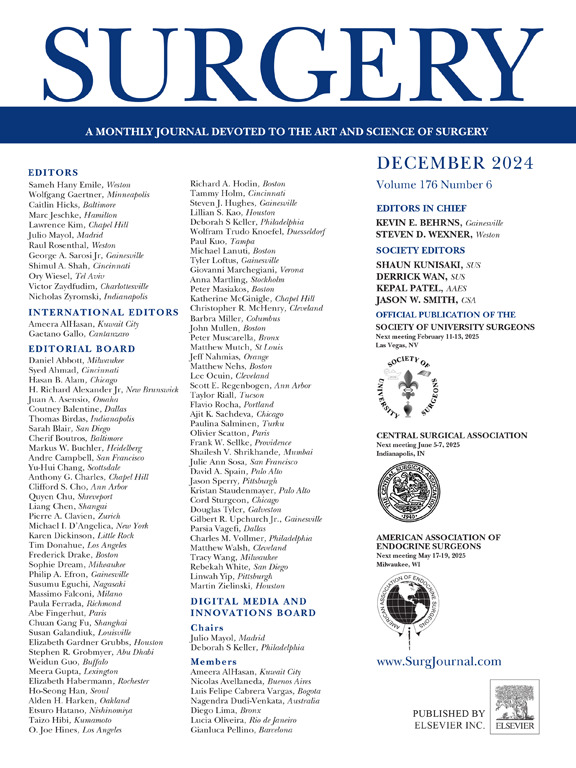终末期肝病-甲胎蛋白-肿瘤负荷模型(MELD-AFP-TBS)评分对肝癌肝切除术后预后进行分层
IF 3.2
2区 医学
Q1 SURGERY
引用次数: 0
摘要
形态学标准,如巴塞罗那临床肝癌分期系统,往往不能准确预测肝切除肝癌患者的长期生存。我们试图开发一种持续的风险评分,该评分结合了肿瘤生物学和肝功能的既定标志物,以改善对总生存期的预测。方法来自多机构数据库的数据用于识别接受治疗意图肝切除术的肝细胞癌患者。采用多变量Cox回归模型的加权β系数,对总生存率进行预测评分。结果850例患者中,595例(70.0%)被分配到训练组,255例(30.0%)被分配到测试组。在培训队列中,多变量分析确定了终末期肝病模型(风险比,1.04;95%可信区间,1.01-1.07),对数转化的甲胎蛋白(风险比,1.07;95%可信区间,1.02-1.13)和肿瘤负荷评分(风险比,1.07;95%可信区间(1.03-1.11)作为总生存率较差的独立预测因子。终末期肝病-甲胎蛋白-肿瘤负荷模型评分,基于Cox模型,将患者分为低危(n = 466, 78.3%)和高危(n = 129, 21.7%)两组,前者5年OS为70.5% (P <;措施)。在试验队列中,终末期肝病-甲胎蛋白-肿瘤负荷模型评分(C-index: 0.72,曲线下时间依赖面积1年:0.80,3年0.76,5年0.70)比巴塞罗那临床肝癌分期系统(C-index: 0.53,曲线下时间依赖面积1年:0.61,3年0.55,5年0.56)具有更好的判别准确性。终末期肝病模型(https://jk-osu.shinyapps.io/MELD_AFP_TBS/.ConclusionThe)提供了一个在线工具——甲胎蛋白-肿瘤负担评分,为肝细胞癌患者的预后分层提供了一种新颖、准确的工具,识别出可能受益于替代治疗以改善预后的高危患者。本文章由计算机程序翻译,如有差异,请以英文原文为准。

Model of End-Stage Liver Disease–alpha-fetoprotein–tumor burden (MELD-AFP-TBS) score to stratify prognosis after liver resection for hepatocellular carcinoma
Introduction
Morphologic criteria, such as the Barcelona Clinic Liver Cancer staging system often fail to accurately predict long-term survival among patients undergoing liver resection for hepatocellular carcinoma. We sought to develop a continuous risk score that incorporates established markers of tumor biology and liver function to improve the prediction of overall survival.
Methods
Data from a multi-institutional database were used to identify patients who underwent curative-intent hepatectomy for hepatocellular carcinoma. A predictive score for overall survival was developed using weighted beta-coefficients from a multivariable Cox regression model.
Results
Among 850 patients, 595 (70.0%) were assigned to the training cohort, and 255 (30.0%) to the test cohort. In the training cohort, multivariable analysis identified the Model of End-Stage Liver Disease (hazard ratio, 1.04; 95% confidence interval, 1.01–1.07), log-transformed alpha-fetoprotein (hazard ratio, 1.07; 95% confidence interval, 1.02–1.13), and tumor burden score (hazard ratio, 1.07; 95% confidence interval, 1.03–1.11) as independent predictors of worse overall survival. The Model of End-Stage Liver Disease–alpha-fetoprotein–tumor burden score, based on the Cox model, stratified patients into low-risk (n = 466, 78.3%) with a 5-year OS of 70.5% and high-risk (n = 129, 21.7%) with a 5-year OS of 47.0% (P < .001). In the test cohort, the Model of End-Stage Liver Disease–alpha-fetoprotein–tumor burden score demonstrated superior discriminative accuracy (C-index: 0.72, time-dependent area under the curve 1-year: 0.80, 3-year 0.76, 5-year 0.70) compared with the Barcelona Clinic Liver Cancer staging system (C-index: 0.53, time-dependent area under the curve 1-year: 0.61, 3-year 0.55, 5-year 0.56). An online tool was made accessible at https://jk-osu.shinyapps.io/MELD_AFP_TBS/.
Conclusion
The Model of End-Stage Liver Disease–alpha-fetoprotein–tumor burden score provides a novel, accurate tool for prognostic stratification of patients with hepatocellular carcinoma, identifying high-risk patients who may benefit from alternative treatments to improve outcomes.
求助全文
通过发布文献求助,成功后即可免费获取论文全文。
去求助
来源期刊

Surgery
医学-外科
CiteScore
5.40
自引率
5.30%
发文量
687
审稿时长
64 days
期刊介绍:
For 66 years, Surgery has published practical, authoritative information about procedures, clinical advances, and major trends shaping general surgery. Each issue features original scientific contributions and clinical reports. Peer-reviewed articles cover topics in oncology, trauma, gastrointestinal, vascular, and transplantation surgery. The journal also publishes papers from the meetings of its sponsoring societies, the Society of University Surgeons, the Central Surgical Association, and the American Association of Endocrine Surgeons.
 求助内容:
求助内容: 应助结果提醒方式:
应助结果提醒方式:


